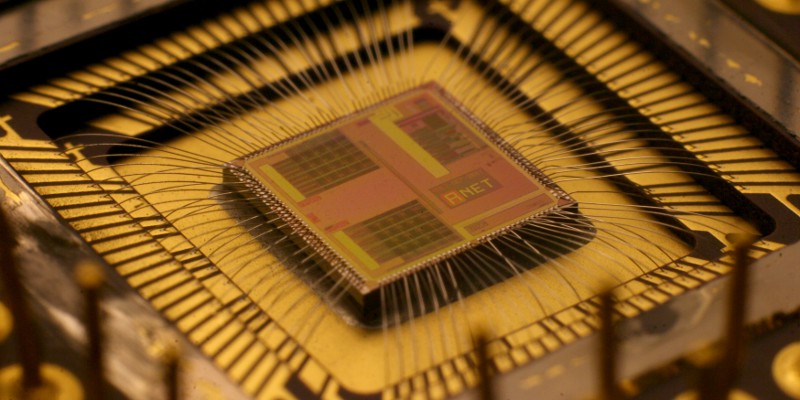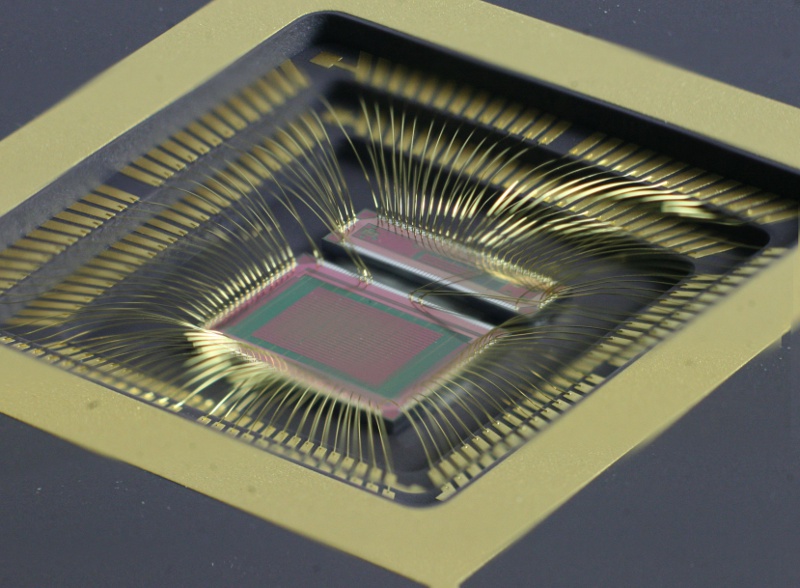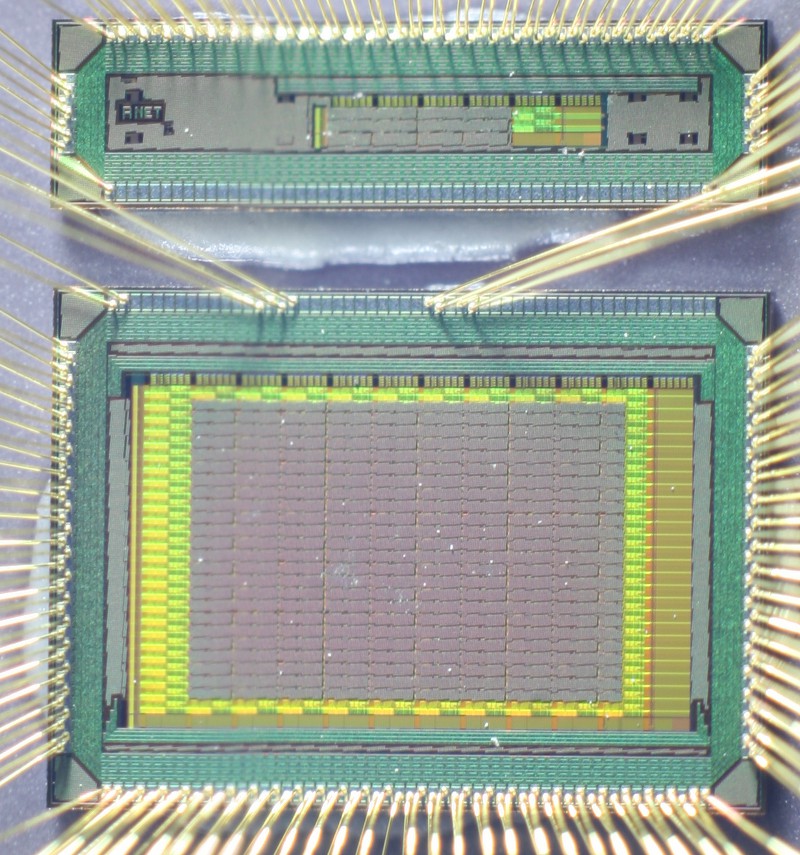RNET had worked on chip and board level research and development projects, but is no longer actively pursing work in this area. Work included research into the development of novel FPGAs (radiation hardened and ultra-low power designs), read out integrated circuits (radiation and temperature hardening, and developments for strained layer superlattice photodetectors), and a Fault Tolerant Mid-Wave Infrared (MWIR) detector.
Radiation hardened FPGA and Ultra Low Power Design
This design is a field programmable gate array (FPGA) architectures that are highly tolerant to radiation. NASA was interested in highly radiation tolerant devices for future exploration missions, including the Europa-Jupiter System Mission (EJSM) that requires a hardness of at least 2.9 Mrads total ionizing dose (TID). Potential applications exist in space vehicles, satellites, orbiters, and others.
The initial prototype was for a reprogrammable SRAM-based FPGA that can withstand a very high total ionizing dose (TID), mitigate single event upsets (SEUs), and have latchup immunity. TID tolerance is provided through a proprietary active compensation method and hardened circuitry capable of exceeding the requirements of EJSM. The architecture included techniques for the mitigation of temperature effects as well. Prototype FPGA devices have been fabricated on a 5mm x 5mm die using a SiGe process technology and are in the process of being characterized. The current device has a main die that contains a small prototype FPGA with 27x11 multi-input logic cells. Included are the proprietary compensation circuits, SEU enhanced SRAM, configuration circuitry, and I/O. There is also a smaller die containing isolated components of our environment compensation mechanism and numerous experimental circuits. Radiation test parameters include TID characterization well beyond the 2.9 Mrads requirement for EJSM program and SEU characterization. A second project built on the earlier radiation hardened FPGA design and extended it both in functionality and features. It was the vision of RNET to develop a family of radiation hardened FPGA products with a variety of features including programmable logic, configurable analog functions, soft/hardcore microprocessor, dedicated DSP functions, configurable I/O, dedicated memory blocks, memory controllers, high performance clock networks, and JTAG interface.
 .
. 

Radiation/Temperature Hardened Advanced Readout Array with Dynamic Power Modes
NASA had an interest in the development of advanced instruments and components for Lunar and planetary science missions. Instrumentation was needed for the exploration of inner and outer planets and their moons, comets, asteroids, etc. As a consequence, instrumentation systems must withstand the extreme surroundings experienced in space and planetary environments; radiation, temperature, pressure, launch/landing stresses, etc. Specific areas related to instrument deployment for in situ sensors and sensor systems on a variety of space platforms including orbiters, flyby spacecraft, landers, rovers, balloons, and other aerial vehicles, sub-surface penetrators, and impactors are of interest.
In the Phase I program, an innovative digital readout integrated circuit (DROIC) architecture that will increase resolution and provide improved sensitivity was researched. The low power design incorporated provisions to mitigate the effects of radiation and extreme temperatures. The goal was to target a variety of Flagship missions including EJSM, Mars Astrobiology Explorer-Cacher, Venus Climate Mission, and the Uranus Orbiter/probe. Potential non-NASA applications include persistence surveillance applications for the military. Commercial applications may exist in thermal imaging, hyperspectral imaging, or compressive sensing.
Fault Tolerant Mid-Wave Infrared (MWIR) Detector
Tactical and reconnaissance platforms rely on high performance, multifunctional optical sensor systems. At the heart of many of these optical sensor systems are mid-wave infrared (MWIR) focal plane arrays (FPA) for their ability to provide high resolution images regardless of the daylight conditions. Larger arrays are required to attain higher resolution and expanded capabilities. However, such dramatic improvements have resulted in lower yields due to manufacturability. Industry has demonstrated techniques to provide fault tolerance to the FPA, however, improvements can be achieved. As a direct result, this project developed the integration of fault tolerance technologies into the readout integrated circuit (ROIC) of the FPGA to overcome yield difficulties. Schematic designs of fault tolerant circuit technologies, simulations, and performance verification will be performed. The technology developed under this SBIR would enable the development and fabrication of larger, more capable mid-wave infrared focal plane arrays with intrinsic fault tolerance to overcome manufacturing issues. It is anticipated that this technology would provide direct benefits to many DoD applications where improved FPAs are needed. In addition, fault tolerant ROIC technologies would also benefit commercial applications, including general surveillance, topographical surveying, identification, etc.
Advanced ROIC Technology for Strained Layer Superlattice Photodetectors
The objective of this project was to develop an optimized SLS-based Infrared FPA for high temperature operation with considerations for lower cost, size, weight, and power (C-SWAP). Infrared imaging systems in use today come at a high cost, require large amounts of space, are heavy, and consume large amounts of power. To reduce noise and improve responsivity, such detectors are cryogenically cooled to below -200 ºC, which in combination with C-SWAP requirements greatly limit their applicability for integration into aircraft. Detector structures composed of SLS material have demonstrated the potential to achieve high temperature operation MWIR and LWIR, responsivity similar to HgCdTe detectors, and reduced dark currents. Several improvements have been incorporated into standard ROIC designs to specifically optimize them for use both MWIR and LWIR SLS detector technologies. This approach will result in the fabrication of a SLS-optimized ROIC that will be hybridized with a detector, resulting in focal plane arrays with superior capabilities in terms of high temperature operation, responsivity, and reduced dark currents for insertion into both MWIR and LWIR imaging systems on multiple surveillance, threat warning, and situational awareness platforms.

